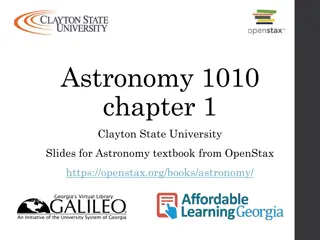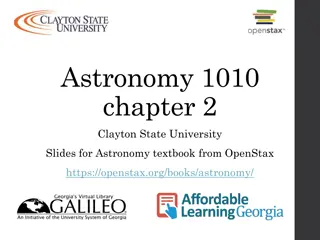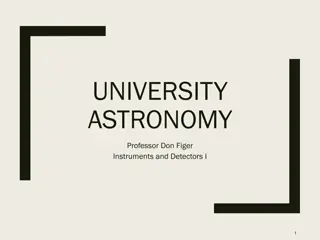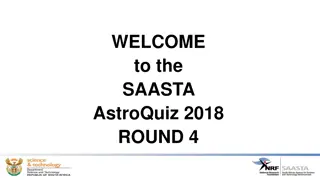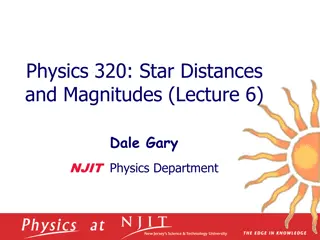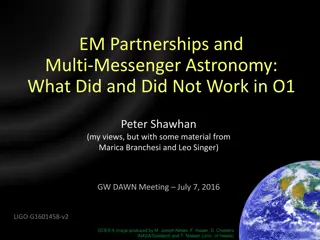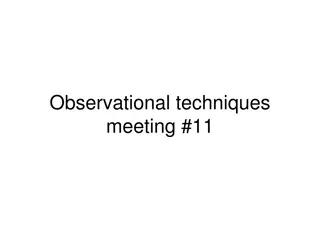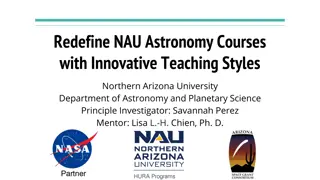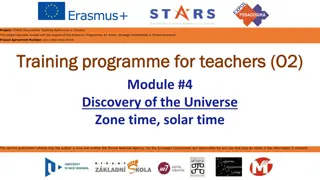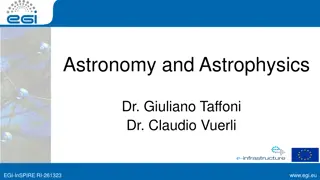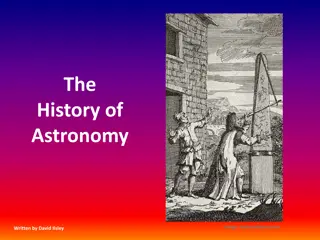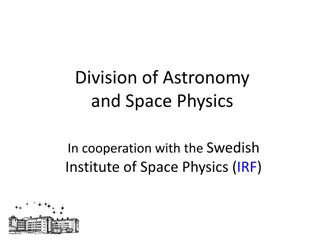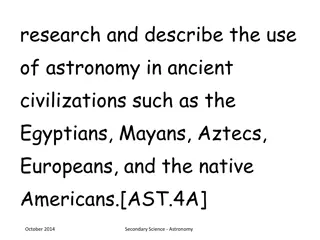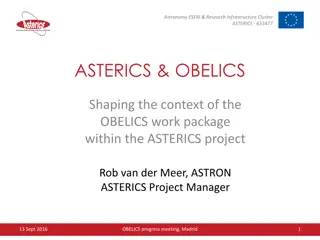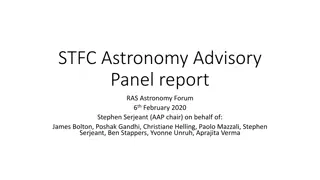Advanced Methods in Astronomy Research
Utilizing high-speed photoelectric observations, video recordings, and VizieR catalogue data, astronomers have revolutionized occultation research, enabling precise measurements of lunar irregularities, asteroid sizes, and stellar characteristics. With advancements like Limovie tool, amateurs are now able to contribute significantly to this field by submitting light curves for archiving.
Download Presentation

Please find below an Image/Link to download the presentation.
The content on the website is provided AS IS for your information and personal use only. It may not be sold, licensed, or shared on other websites without obtaining consent from the author.If you encounter any issues during the download, it is possible that the publisher has removed the file from their server.
You are allowed to download the files provided on this website for personal or commercial use, subject to the condition that they are used lawfully. All files are the property of their respective owners.
The content on the website is provided AS IS for your information and personal use only. It may not be sold, licensed, or shared on other websites without obtaining consent from the author.
E N D
Presentation Transcript
Dave Herald Murrumbateman 1
VizieR catalogue: B/occ Can query using Star ID, observer name, and more Can plot, by clicking the LCxxx Seq no. 1671 light curves, soon to exceed 2000. ALL OBSERVERS ARE ENCOURAGED TO SUBMIT LIGHT CURVES FOR ARCHIVING! 2
A video recording at 30fps will easily attain an angular resolution of 0.01 in a lunar occultation, this is a factor of at least 50 greater than resolution provided by normal telescopes subject to the Earth s atmosphere; even better than Gaia Video recording lunar occultations provides a tool for surveying the size &/or presence of companions at a resolution of ~0.01 , in an 11 band centred on the ecliptic, 4
Prior to ~2000, almost all occultation observations were made visually The objective was to determine the time of the event and nothing else Lunar occultations: measure the irregularity in the Earth s rotation Asteroidal occultations: measure the size and shape of asteroids 5
high speed photoelectric observations of lunar occultations have been made since the 60 s. Number is small, and used large telescopes Discovered double stars, measured stellar diameters (and light distribution across large stars such as Aldebaran & Antares), and had to deal with Fresnel diffraction 6
Amateurs started using video from about 2000 For many years, video analysed visually via video playback Some (most notably in Europe) converted individual frames into FITS files, and used traditional CCD imaging tools to conduct a photometric measure of the star over a series of FITS files But focus remained on establishing the event time, and not on the light curve per se 7
~2005 Limovie - the first tool that enabled simple but reliable measurement of a video KIWI-OSD a device to reliably insert a GPS- based time stamp on videos Tangra a second tool for measuring video focussed primarily on asteroidal events IOTA-VTI a replacement for the KIWI-OSD (which had been withdrawn from sale) 8
By 2010, video recoding of occultations, using a time inserter, had become the norm Occasionally people noted steps in their light curves as measured by Limovie or Tangra A system was developed to report and analyse double stars measured or discovered in this way However many stars previously reported as double by visual observers did not display step events on a video measurement. Many showed gradual events, consistent with either Fresnel diffraction or stellar diameter 9
An important issue with double star observations is to be able to combine multiple measurements to derive a solution for the PA and separation There have been several instances where an old video recording of a lunar occultation has been measured using modern tools with the light curve showing a step event 10
Recently the Kepler mission came to an end due to the failure of gyroscopes required for pointing the satellite However it was determine that the satellite could observe areas of the sky along the ecliptic for about 3 months at a time using the two remaining gyroscopes in combination with the solar wind This mission is called K2 A researcher involved with K2 noted that occultation light curves of target stars could be very useful when analysing the K2 results 11
The fields observed by K2 continue to expand but are all located along the ecliptic 12
To maximise the value of the video observations we make, we need to archive the light curves we record Archiving makes the light curves available to all for future investigations Remember that a light curve that does not show a companion is not proof the star is singular. It may have a companion in an elliptic orbit, and a light curve that does not show a companion may still be useful when determining the orbit 13
VizieR are keen & supportive of us archiving light curves with them VizieR have assisted in developing a format for submitting light curve observations to them Process for reporting observations has been made as simple as possible. I hope!... Limovie has been updated to facilitate transferring light curve data to Occult (Tangra already had the required capability) 14
Enter the observation into the OCCULT Lunar Observations editor, in the usual fashion After the observation has been entered, make sure the observation entry is highlighted in the Events screen then click the menu item 15
Occult generates all the information required to support the observation All you need to do is copy the light curve as a CSV file from Limovie or Tangra, and paste into the report. 16
Reporting a light curve Lunar (3) Select the start and end of the segment of the light curve to be reported 17
Click Save this report to save on your PC Periodically, click Email multiple saved reports to submit them. Occult will periodically remind you. Default reminder interval is one month 18
From Asteroid Observations tab, click Light curves Report This will open the Light Curve report form, with some changes specific to asteroids. 19
First step Paste (or open) the light curve report Second step click and then enter the details. 20
Site details can be set as default values Click Get coords from Star to retrieve equivalents Click Transfer data and Exit when done 21
Select the start and end of the segment of the light curve to be reported as per lunar occs. However the light curve will usually be much longer Save as per lunar occs. The light curve will be saved in the same location as lunar light curves Submit in same manner as for lunar light curves 22
The light curves are a download in Occult Light curves can be viewed by star number In Lunar occultation predictions stars with a light curve available are flagged. The light curves can be viewed via the right-click menu Currently, over 1,600 light curves available. Soon to be >2000. 23
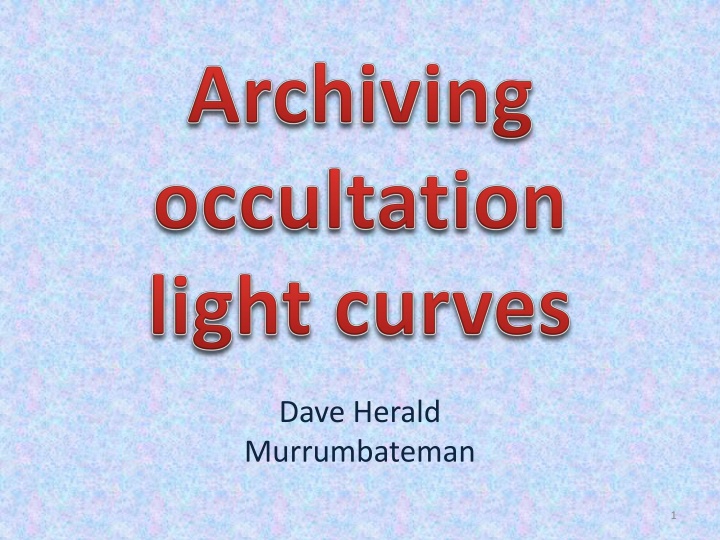

![READ⚡[PDF]✔ The Earth in Context: A Guide to the Solar System (Springer-Praxis S](/thumb/21508/read-pdf-the-earth-in-context-a-guide-to-the-solar-system-springer-praxis-s.jpg)
![[PDF⚡READ❤ONLINE] Cosmology and Particle Astrophysics (Wiley-Praxis Series in As](/thumb/21627/pdf-read-online-cosmology-and-particle-astrophysics-wiley-praxis-series-in-as.jpg)

